Mexico City; Day Three - Meals, Murals, Museums, Mass & El Moro
Wednesday, December 24, 2008 (A Mexican Christmas Eve)
Finding Breakfast
Looking for yet another special place to eat a traditional breakfast, we went to the Sheraton hotel around the corner from our hotel where we had been told there was an excellent Mexican restaurant. But it was closed already for Christmas eve. We asked the concierge for other breakfast options, as well as whether El Moro would be open that night, and the hours for the Admirals Club at the airport. We settled on Café Tacuba once again for breakfast and set out. In the Alameda we saw men on horseback, the first we'd seen in what some of us think of as "traditional Mexican garb." It turns our they were park police.

The Central Post Office was open and we enjoyed looking in.


From the inside the marble floor looks as though it is water.

At Café Tacuba we enjoyed another excellent breakfast and the best hot chocolate we had in Mexico City. A male a capella trio serenaded the customers with Christmas songs. Debbie ordered a bowl of papaya and we remarked, once again, that in Mexico lime seems to go on everything.
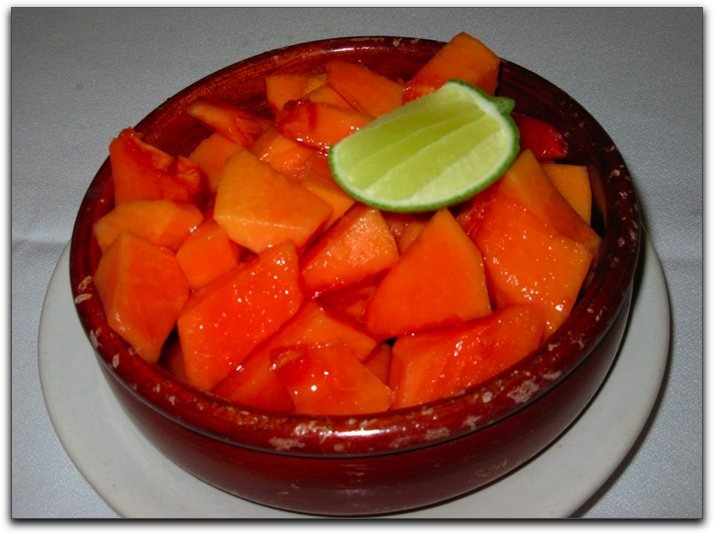
We had become accustomed to three course breakfasts (though we usually skipped the pastries):
- juice or fruit
- main course
- pastries
Nonetheless, the breads disappointed us. We are used to "solid" bread filled with whole grains and often nuts. In Mexico, the bread was generally white, spongy, dry, flaky and nearly tasteless (unless it was the Pan de Yema we had enjoyed in Oaxaca… but that seemed more like cake, than bread, with its anise). Mark ate chiles rellenos and Debbie ordered enchiladas in a mole, each made with cheese. Miriam and Luis had told us that all cheese in Mexico is a form of "mozzarella/string" cheese, known as "Oaxacan Cheese." And, so they were.
The city is one big market… both open air, inside stalls, stores and spilling onto the street.
We continued to ask all over (various concierges, maitres d', anyone with whom we could communicate in our limited Spanish) for good quality vanilla extract. This kind of a quest makes for fun interactions with local folks.
Murals of Belles Artes
We finally paid for admission to see the murals in the Bellas Artes opera house. Climbing the rose and black marble art deco staircase a couple of flights, we came upon Diego Rivera's Man at the Crossroads. We were familiar with the painting from, among other sources the movie Cradle Will Rock based on the opera of (nearly) the same name The Cradle Will Rock by Marc Blitzstein which we had seen in La Jolla with Avigail, Noam and Bobe when it first came out. Now, we stood in front of the huge painting and were able to study and enjoy it at some leisure. We noticed in the lower right corner, just above eye level a Yiddish translation of "Workers of the World, Unite. You have nothing to lose but your chains!" Unfortunately, photographs were prohibited and Mark has been unable to find a reproduction Online, nor a listing of the other wonderful murals visible there.
Search for El Moro
Our flight from Mexico was scheduled for approximately 6:30 AM. Working back, we calculated that we needed to leave downtown Mexico City for the airport by 4:00 at the latest. This would have meant awakening by 3:00 for showers and final packing, calling the authorized cab, etc. If we were to attend Midnight Mass at the Cathedral… it hardly seemed worthwhile going to sleep (and paying the hotel for barely using the room). But, what might we do during those few hours between Mass and the trip to the airport? As we reviewed the possibilities (the Admirals' Club at the airport?) with Luis and Miriam via email, Luis wrote:
But, most importantly, a few blocks from the hotel in Eje Central there is an old popular "restaurant" that sells ONLY chocolate (hot, 4 different kinds) and churros. A must for a scholar on "Jews on the Chocolate Trail". The name is "El Moro" ...
This seemed to be precisely what we were hoping for… especially if it had electricity and wireless. So that morning, after confirming with the concierge at the Sheraton that it is "OPEN 24/7/365" we made our way over to make sure we could find it. Indeed, El Moro was barely five blocks from our hotel. And we had walked past it without knowing it on our first day when we walked from the Artisans' Market to dinner at the Café Tacuba. But, not surprisingly, we missed it. It is old and not "inviting" from the street. Even this morning when we were searching for it and asking for it, we almost missed it. Almost cavernous, a slightly grungy room, Mexican ceramic enameled tiles line the walls. The kitchen is up front and serves out the window to the street as well as to the inside. At 11:00 AM it was fairly full. We looked around for electrical outlets but could not find any; and so, also, we were told that there is no available electricity. Nonetheless, we figured that for the couple of hours we would need (given the dearth of other possibilities), El Moro would work out fine. We went back to our hotel, did our final packing and checked out of the room, leaving our bags with the bell man, continuing with our final day in Mexico.
Vanilla Again… More or Less
On our search for vanilla, the concierge had suggested the "supermarket" (part of a chain) a couple of blocks from the hotel in the direction we were headed: Aurerra Express. While we had the name written down, Mark kept asking for it with an incorrect pronunciation "Aurora" and people even a block away from it stared at us not understanding our question. When we finally took out the slip of paper, we were directed to a tiny opening that looked more like a convenience store than a supermarket… but we entered and asked again. "Vanilla" in Spanish is "Vainilla"; the "v" sounds like softly attacked "b" and the "i" of the second syllable is not only stressed, but extended: "eeee!" Even asking for the item was an adventure in communication. Three different attendants in the store helped us and finally led us to:
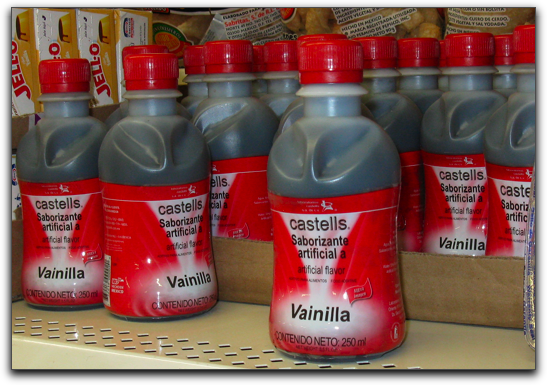
This may have been "vainilla", but it was definitely not what we were looking for. It was made from (from the label): "Water, Ethyl Alcohol, Propylen glycol, Artificial Flavors and Natural color (Caramel)." We did not buy it.
More Murals
We continued one or two blocks from the Aurerra Express on Balderas street to the Diego Rivera Mural Museum where we could sit and appreciate his 1947 fresco masterpiece Sueño de una tarde dominical en la Alameda Central (Dream of a Sunday Afternoon in the Alameda) which may be a pun on A Sunday Afternoon on the Island of La Grande Jatte. Once again, the Catrina held center stage.
Upstairs we found a museum dealing with the Inquisition, and while there were a number of references to Jewish matters, there was nothing about chocolate.
Metro to Museum
Around the corner from the Diego Rivera museum, we stopped at a little café for tea, then walked around the corner once again past a tiny museum dedicated to José Martí (who wrote the words to Guantanamera). Beside that was an entrance to the metro, which, with the usual transfer, took us to Chapultepec park. By this time we were familiar with the neighborhood and easily found our way into the park, following our map and the signs (or so we thought) to the Museo Nacional de Historia, which we felt should be part of our research. Our map was not topographic and we wandered a bit until we found the path up to the museum in the castle. The walk up was good and aerobic. At the top, the 19th century tower from the castle lines up nicely with the 21st century Torre Mayor (where we had picked up a taxi the previous night).
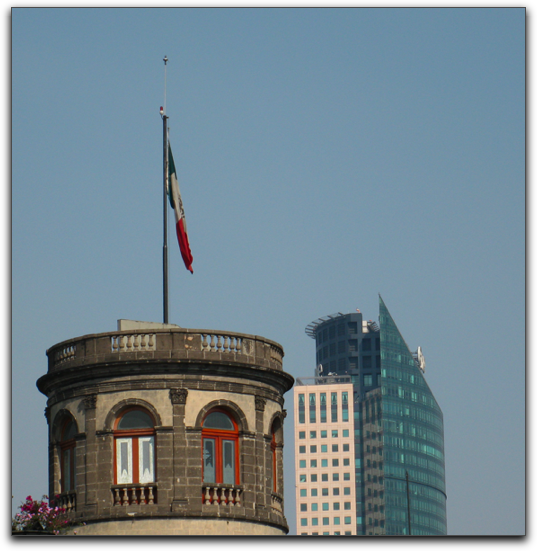
The castle had been used by the emperor Maximilian during the period when the French controlled Mexico. We did not see much history there, and even less chocolate. We did see more amazing murals and have wondered about the origins of the mural culture in Mexico. Mark, who enjoys theorizing, suggests that it may have to do with the extensive public pre-Columbian wall art. On the other hand, Loren thinks that it emerges from Soviet Realist propaganda painting on railroad cars. There's even an Wikipedia article on the subject that suggests other sources. Most of the artifacts in the museum date from the period of Maximilian, including a gloriously gilded mirror in which we took our portrait (as we recalled the portrait we took at the Reichstag in Berlin in 2006).
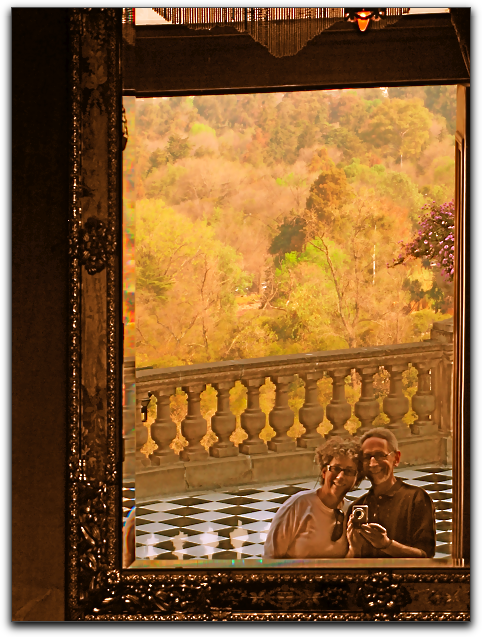
Around the corner the view took in all of Paseo de la Reforma and another "photo-op"
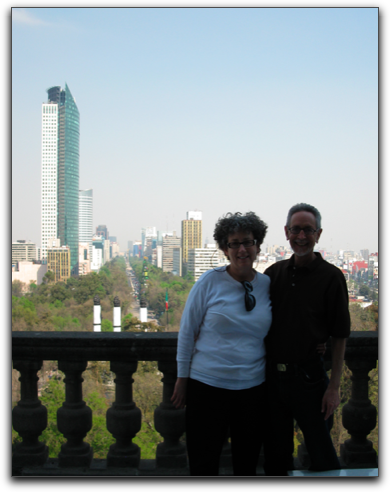
Walking back down was quicker. We rested a bit on a park bench from which we could see the patio where the previous picture had been taken.

Walking back to the center of town, we looked for a place to have our final meal in La Zona Rosa for lunch at Fonda el Refugio. The food was delicious and plentiful, the ambiance was equally as lovely. For dessert they offered us the black dessert (zapote negro or black sapote) that Luis had made for us a few days earlier. We opted for the orange looking dessert, camote con pina. Before we finished and paid, the waiter brought us a bowl of fruit with peanuts and sugar cane, indicating that this was the "piñata."
Our walk continued along Paseo de la Reforma past the Palmera with the sun setting behind La Glorieta del Angel de la Independencia.
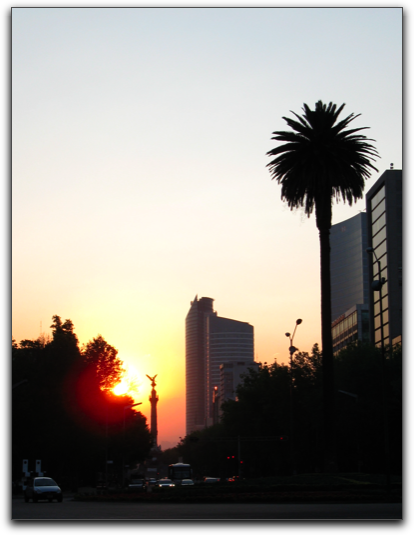
Then further toward the intersection of Iturbe and Avenida Juárez, we suddenly saw a fountain shooting water into the air and a bit to its left, sparks fell from above causing a splash of more sparks. Click the picture or the link to watch the movie.

FireWater, 2008
Quicktime movie (4.9MB, 12 seconds)
PG13
When we reached the Zócalo, before going to Mass, we saw another person walking with one of those familiar bags made from a kosher sugar sack.

In the full chapel in the Cathedral we were able to find a small area in the back where we could lean against the wall and then later move to a back pew. Mass was in progress, earlier than we had been told it would occur. We watched uncomprehending, though we could understand a bit of the Spanish and some of the songs were familiar.
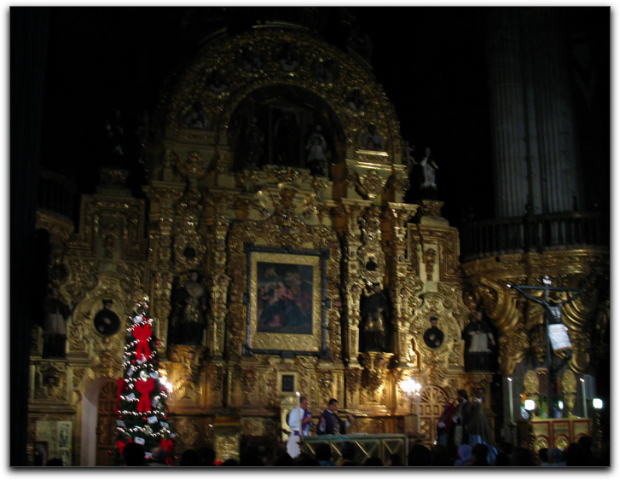
Among the huge panels of Christmas lights, this holy family resembled the indigenous peoples of Mexico more than Judaeans of 2000 years ago.
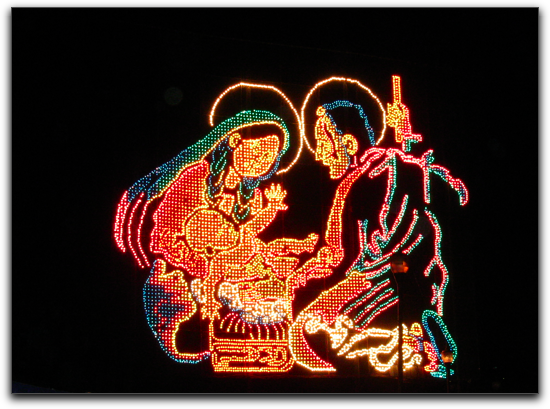
From the Cathedral and the Zócalo, as planned, we walked over to El Moro. When we arrived, we were disappointed to see cafe it was closed and dark.
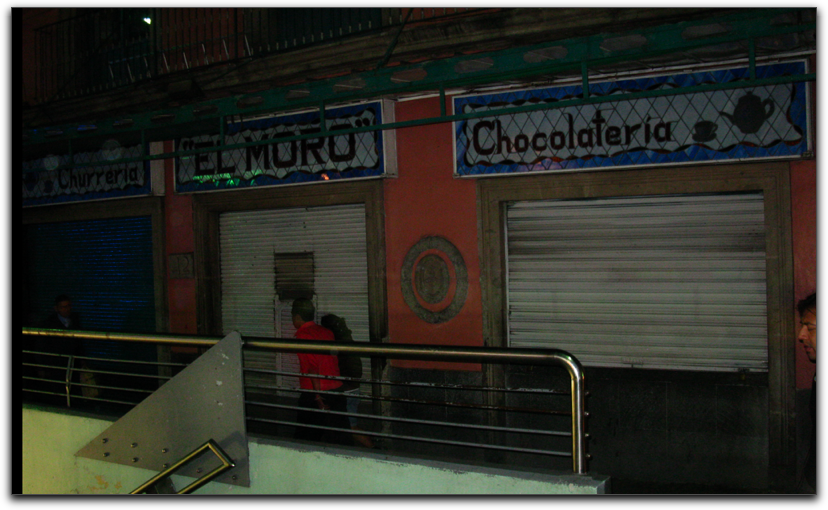
We returned to the lobby of the hotel where we shared the electricity, responded to email, prepared the Web site and napped. At about 4:00 AM we called for an authorized cab and headed off to the airport.
start || back || next

















